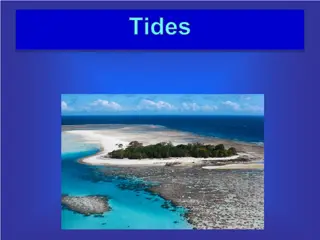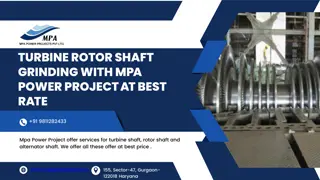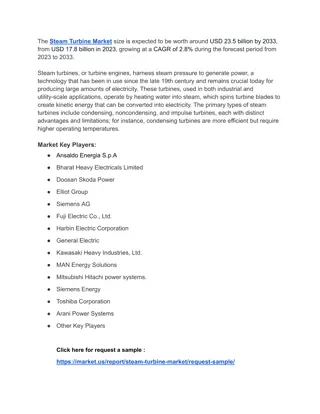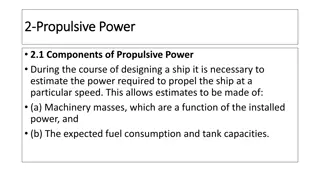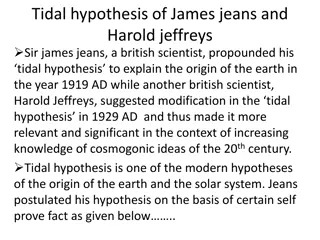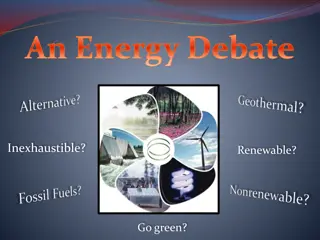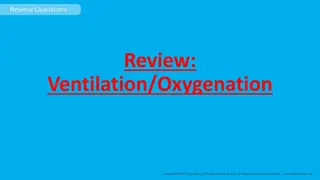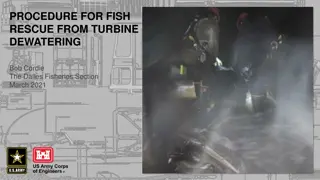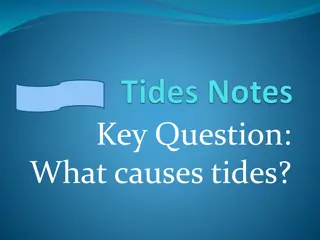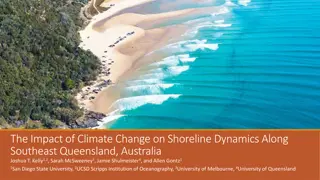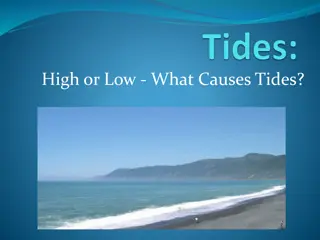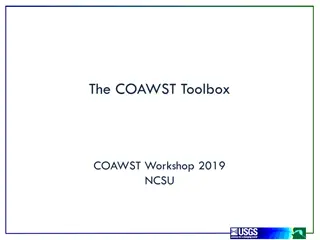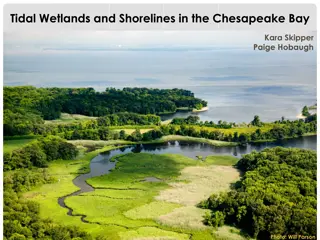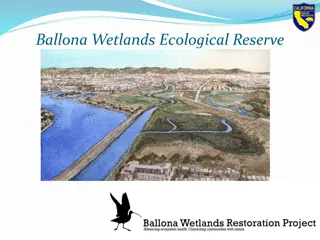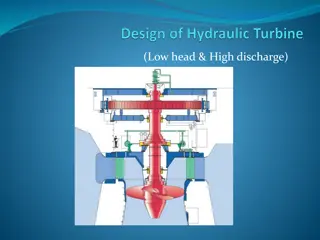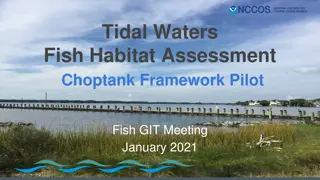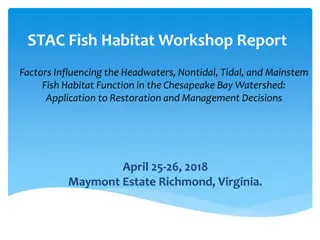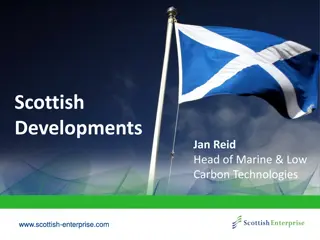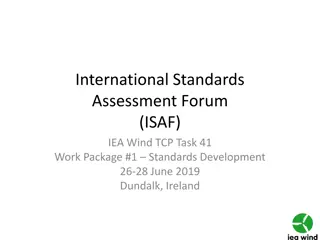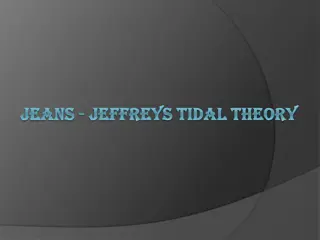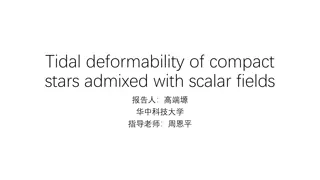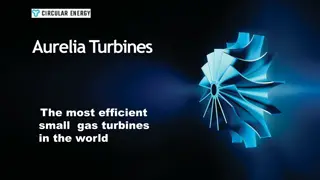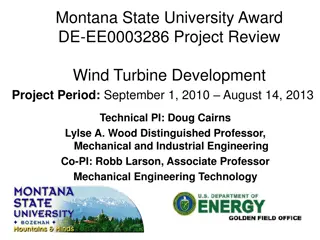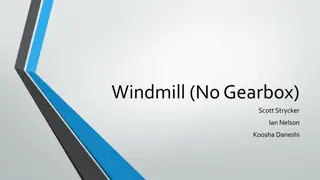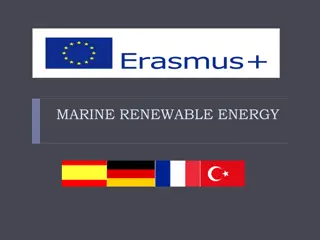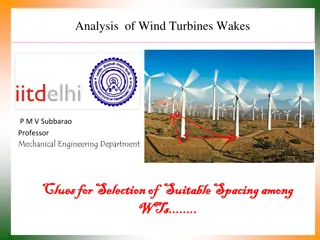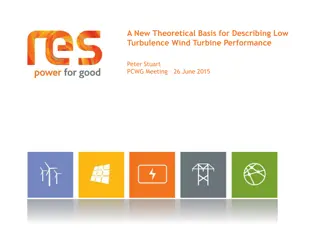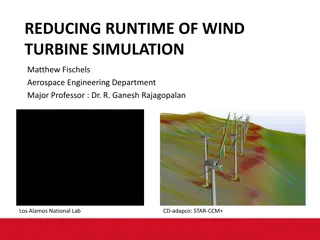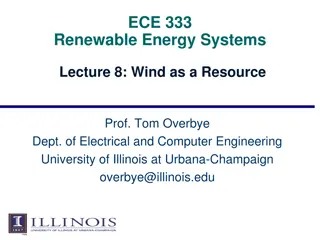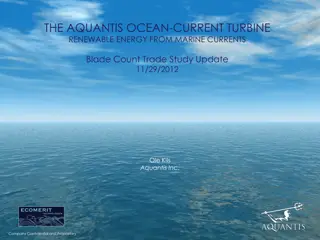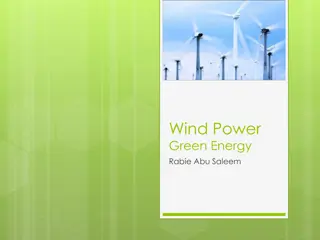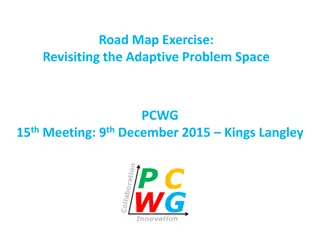Green Energy Market
Green energy also referred to as clean energy, is usually derived from natural sources that are constantly replenished. Solar energy, wind energy, hydroelectric power, biomass energy, geothermal energy, tidal energy, and wave energy are different types of renewable energy. Solar energy is the radian
5 views • 6 slides
Understanding Tides: Causes, Types, and Phenomena
Explore the fascinating world of tides, from what causes them to the daily cycle of high and low tides. Discover why the moon plays a significant role in influencing tides and how tidal currents contribute to the dynamic movement of ocean waters. Learn about the gravitational forces of the Earth, Mo
3 views • 30 slides
Modelling Estuarine Habitats in the Upper Sea Scheldt: Human-Induced Adaptations
Explore a research study on modelling estuarine habitats in the Upper Sea Scheldt under various human-induced channel and floodplain adaptations. The study examines the impact of interventions on habitat size, water quality, ecosystem, and more, providing insights into the future of the estuarine en
3 views • 13 slides
TURBINE ROTOR SHAFT GRINDING
Mpa Power Project's turbine rotor shaft grinding service offers the pinnacle of precision engineering. To guarantee optimum performance and longevity, our qualified specialists carefully polish the turbine rotor shafts to precise standards. We expertly restore worn-out or damaged rotor shafts to per
3 views • 9 slides
Understanding Tides and Earthquake Triggers
Spring tides occur when the moon is new or full, resulting in higher high tides and lower low tides. Neap tides follow, with moderate tides. Tides can trigger earthquakes due to stress and tidal components like normal and shear stresses. Statistical tests analyze the tidal phase angles at the time o
0 views • 25 slides
Steam Turbine Market: Key Drivers and Challenges
The Steam Turbine Market size is expected to be worth around USD 23.5 billion by 2033, from USD 17.8 billion in 2023, growing at a CAGR of 2.8% during the forecast period from 2023 to 2033.
2 views • 5 slides
Understanding Ship Propulsion Power Estimation
In the process of ship design, it is crucial to estimate the power required for propulsion to determine machinery masses, fuel consumption, and tank capacities. Power estimates can be derived through comparisons with existing vessels or model tests, involving scaling laws for different components. S
0 views • 19 slides
The Tidal Hypothesis of James Jeans and Harold Jeffreys: Origin of the Earth
The Tidal Hypothesis proposed by British scientists James Jeans and Harold Jeffreys in the early 20th century suggested that the Earth and solar system were formed from the interaction of the Sun and an intruding star. Jeans postulated that massive gravitational forces from the intruding star caused
2 views • 5 slides
Understanding the Debate on Inexhaustible vs. Nonrenewable Energy Sources
The energy debate revolves around the classification of energy sources into nonrenewable, renewable, and inexhaustible categories. Fossil fuels, such as coal, petroleum, and natural gas, fall under nonrenewable sources due to their finite nature, while wind and tidal energy are examples of inexhaust
0 views • 18 slides
Understanding Ventilation and Oxygenation in Respiratory Care
Review covers key concepts of ventilation and oxygenation, including the control of breathing, assessment of tidal volume, and the roles of different respiratory centers. Learn about the importance of observing chest rise to assess tidal volume accurately. Gain insights into the brain stem's pivotal
6 views • 41 slides
Guide to Fish Rescue from Turbine Dewatering Process
Detailed procedure for rescuing fish from turbine dewatering, including steps like hoisting sturgeon, salvaging fish in tanks, and using gantry cranes to transport them. The process involves specialized equipment and careful handling to ensure the safety of the fish. Images illustrate key steps in t
2 views • 9 slides
Understanding Tides: Causes, Forces, and Patterns Explained
Explore the fascinating world of tides, from their causes - the gravitational forces of the sun and moon, to the concepts of tidal range, spring tides, and neap tides. Discover how these natural phenomena impact our oceans and environment in a rhythmic cycle of ebb and flow.
0 views • 11 slides
Impacts of Climate Change on Shoreline Dynamics in Southeast Queensland, Australia
The study focuses on understanding the influence of climate phenomena like ENSO, SAM, and STR on shoreline change along the wave-dominated coast of Southeast Queensland. Utilizing a shoreline dataset mapped over two decades, the research explores the variability in wave climate and its correlation w
3 views • 13 slides
Understanding the Causes of Tides and Their Effects on Earth
Tides are a result of the gravitational interactions between Earth, the Moon, and the Sun. The Moon's gravity creates tidal bulges on Earth's surface, leading to the daily rise and fall of water levels known as tides. These phenomena have a significant impact on ocean coastlines and the overall wate
0 views • 16 slides
Overview of the COAWST Toolbox and its Components
The COAWST Toolbox is a suite of MATLAB tools, scripts, and functions that offers standard functionalities for creating grids, initial conditions, atmospheric forcing, boundary conditions, and climatology files for COAWST. It includes tools for creating tidal forcing files, and ROMS expects specific
0 views • 51 slides
Surface Water-Groundwater Interactions and Nitrogen Cycling in a Tidally Influenced River Study
Study on the dynamic interactions between surface water and groundwater in a tidal river, focusing on nitrogen cycling. The research highlights the impact of tidal fluctuations on bank storage, nitrogen transformation, and nutrient cycling. Findings suggest that river discharge affects the exchange
1 views • 16 slides
Insights into Neutron Stars: Observations and Implications
Exploring the fascinating realm of neutron stars through astronomical observations and the implications for equations of state (EOS). Delve into the mysteries of neutron star properties, measurement results from projects like PREX/CREX, and the significance of NS masses, tidal deformabilities, and r
0 views • 24 slides
Tidal Wetlands and Shorelines in the Chesapeake Bay: Environmental Impact and Conservation Efforts
Tidal wetlands and shorelines in the Chesapeake Bay face pressures from water, land, storms, upland development, shoreline modification, and sea-level rise. Collaborative efforts like the Fish Habitat Action Team aim to highlight the importance of these ecosystems for fisheries. Projects focus on sy
0 views • 9 slides
Conservation Efforts and Restoration Plans for Ballona Wetlands
The Ballona Wetlands Ecological Reserve is undergoing long-term restoration planning to restore tidal circulation, provide diverse wetland habitats, and create new habitat areas for native species. Various initiatives and projects, such as the Dutch Slough Carbon Sequestration and the EIR Project Go
1 views • 15 slides
Coastal Ecosystems: Salt Marshes and Mangroves Overview
Explore the factors influencing coastal ecosystems like latitude, tidal cycles, wave energy, and geological characteristics. Dive into examples from the Pacific Northwest and southeastern U.S., focusing on salt marsh ecosystems. Learn about plant communities and zonation in salt marsh environments.
0 views • 22 slides
Design and Analysis of Kaplan Turbine for Low Head and High Discharge
The objective of this project is to design and analyze a hydraulic turbine suitable for low head and high discharge conditions, specifically focusing on a Kaplan Turbine. The design considerations include blade profile, power output, specific speed, and turbine selection. Basic calculations and velo
0 views • 13 slides
Tidal Waters Fish Habitat Assessment Choptank Framework Pilot Fish GIT Meeting January 2021
The Tidal Waters Fish Habitat Assessment Choptank Framework Pilot Fish GIT Meeting held in January 2021 discussed background, drivers, and the selection of the Choptank River as a candidate tributary. The project team, responsible parties, actions, and timeline for developing an analytical framework
0 views • 17 slides
Factors Influencing Fish Habitat in Chesapeake Bay Watershed Workshop Report
This workshop report delves into the factors affecting fish habitat function in the Chesapeake Bay Watershed, focusing on headwaters, nontidal, tidal, and mainstem areas. It outlines the workshop process, assessment frameworks, and user needs to support restoration and management decisions. The repo
1 views • 31 slides
Scottish Energy Developments and Innovation in Marine and Low Carbon Technologies
Scotland's energy sector is pioneering climate-friendly initiatives towards decarbonization by 2030. The focus lies on supporting renewable energy sources, enhancing energy system flexibility, efficiency, and resilience, and promoting the marine sector's advancements in tidal energy projects. The co
0 views • 11 slides
Challenges and Developments in Micro Wind Turbine Standards
In the context of the International Standards Assessment Forum (ISAF) and IEC 61400-2, challenges in wind turbine standards development, such as incorrect wind characterization and simplification of load methods, were discussed. Participants from various countries contributed to proposing new standa
0 views • 23 slides
Understanding Jeans-Jeffreys Tidal Theory of Planet Formation
Tidal Theory posits that planets form from condensed materials close to the sun, a concept pioneered by Sir James H. Jeans and Sir Harold Jeffreys. Jeans proposed continuous matter creation in the universe, while Jeffreys explored the solar system's origin and latitude variation through astronomical
0 views • 5 slides
Tidal Deformability of Compact Stars Admixed with Scalar Fields Research Summary
Researchers like C. J. Horowitz and Kwing-Lam Leung are exploring the effects of dark matter, scalar fields, and ultra-light dark matter on compact stars like neutron stars. Methods involve calculating tidal love numbers, using energy-momentum tensors, and studying equilibrium solutions. The study a
0 views • 20 slides
Innovative Small Gas Turbines by AureliaTurbines
AureliaTurbines offers the most efficient small gas turbines in the world, with technology that provides excellent efficiency gains. Their innovative 2-stage turbine process with two separate shafts and generators outperforms the competition. With a focus on core turbine technology and strategic coo
1 views • 8 slides
Wind Turbine Development Project Review at Montana State University
Montana State University conducted research and development on wind turbine systems to enhance energy independence. The project aimed to improve wind energy resources in Montana, create local jobs, and establish a higher technology economy. Tasks included durability research on turbine blades and ma
0 views • 19 slides
Exploring Wind Energy Systems Without Gearbox - Research Findings
Investigating wind energy systems without a gearbox reveals insights on turbine performance and generator efficiency. The data generated highlights differences in output power, current, and RPM between ideal and actual setups. Higher RPM allows for a wider selection of generators, although the curre
0 views • 5 slides
Enhancing Wind Turbine Performance Through PCWG Activities
The PCWG (Performance Characterization Working Group) aims to improve real-world wind turbine performance prediction beyond the simple Power=P(v) equation. By introducing concepts like Inner-Outer Range Decomposition and Average-Specific Decomposition, the group addresses factors such as environment
0 views • 13 slides
Understanding Marine Renewable Energy and Tidal Power
Renewable energy is derived from natural resources that won't run out. Tidal energy harnesses the rise and fall of water levels due to tidal waves, occurring typically twice a day with a 12-hour cycle.
0 views • 9 slides
Advancements in Marine Renewable Energy Technology: A Comprehensive Overview
Cutting-edge developments in marine renewables, particularly tidal energy, are showcased in this event report. The profile highlights the extensive experience of key figures in the field, detailing projects like Tandem Tidal Turbine and ADCP applications. The research dissemination on tidal turbine
0 views • 12 slides
Understanding Wind Turbine Wakes for Optimal Farm Design
Optimizing wind farm design and operation involves analyzing wind turbine wakes to minimize power loss and ensure the safety and efficiency of turbines. Differentiating between near and far wakes, determining suitable spacing between turbines, and assessing wake size are crucial factors in maximizin
0 views • 21 slides
New Theoretical Basis for Describing Low Turbulence Wind Turbine Performance
This study presents a new theoretical basis for evaluating wind turbine performance under low turbulence conditions, highlighting the limitations of existing correction methods. It explores the impact of atmospheric conditions on energy conversion efficiency and proposes a reevaluation of performanc
0 views • 9 slides
Enhancing Wind Turbine Simulation Efficiency Through Algorithm Development
Matthew Fischels from the Aerospace Engineering Department aims to reduce the runtime of wind turbine simulations by developing more efficient computational fluid dynamics algorithms. By focusing on algorithm development such as Runge-Kutta methods and multigrid methods, the goal is to achieve faste
0 views • 17 slides
Understanding Wind Power Generation: Key Concepts and Calculations
Exploring wind power generation concepts, this content delves into the physics behind harnessing wind energy, calculating power in the wind, understanding the impact of wind speed on power generation, and correlating wind turbine size with efficiency and cost-effectiveness. Key equations and example
0 views • 28 slides
Aquantis Ocean Current Turbine Renewable Energy Analysis
An update on a trade study regarding blade count for Aquantis ocean current turbine, discussing ideal hydrodynamic and structural models, calculation approaches, and preliminary results. The study explores the effect of thickness-to-chord ratio on rotor section weight and spar thickness for two- and
0 views • 10 slides
Understanding Wind Power: Historical Development, Turbines, and Statistics
Explore the historical development and statistics of wind power, from the first wind turbine in 1891 to the global capacity growth. Learn about the types of wind turbines - Vertical Axis and Horizontal Axis, their advantages and disadvantages, and various wind turbine models. Discover how wind power
0 views • 28 slides
Analysis of PCWG's Position on Turbine Performance in Outer Range Conditions
The analysis focuses on the PCWG's stance on turbine performance in outer range conditions, highlighting the varying levels of consensus and certainty over the years. The 2014 and 2015 results show the group's position as far from consensus with fluctuations in the political and technical dimensions
0 views • 8 slides

